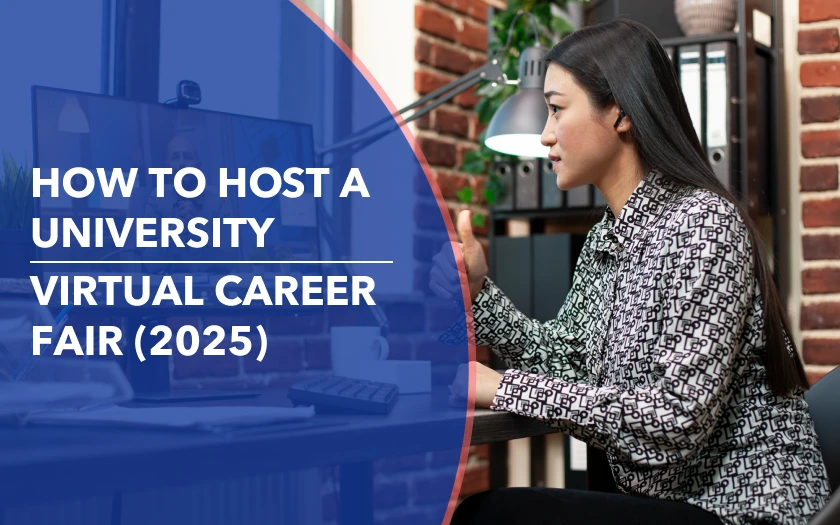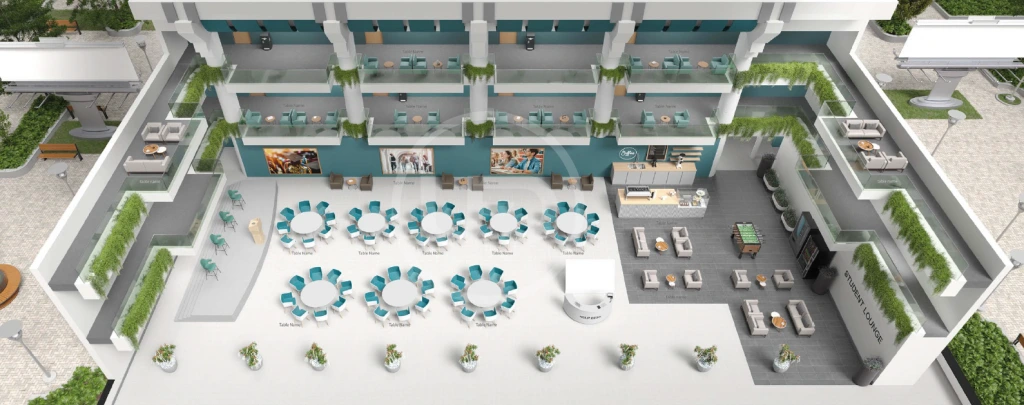How to Host a University Virtual Career Fair (2025 Guide)


A few years ago, a university career fair meant crowded gym floors, printed résumés, and long lines at every booth. Today, those same connections are happening online, with students and recruiters meeting from anywhere in spaces designed to feel genuinely interactive.
Virtual career fairs are now a cornerstone of campus recruitment. They remove travel barriers, open access to more employers, and make participation easier for students juggling classes, jobs, and interviews.
This guide walks you through how to host a university virtual career fair, from setting goals and choosing a virtual career fair platform to creating an experience that’s meaningful, engaging, and as vibrant as any on-campus event.
{{table-of-contents}}
What is a Virtual Career Fair?
A virtual career fair is an online event where students and recruiters meet through live chat, video calls, and interactive booths. Think of it as a flexible, digital venue that still gives everyone a chance to talk, explore opportunities, and make real connections.
Organizers build out this venue with employer booths and live sessions, while students wander through it at their own pace, stopping to speak with recruiters, ask questions, and schedule interviews.
Why Universities and Employers Are Going Virtual
Universities aren’t just testing virtual career fairs anymore, they’re embracing them. The move to virtual job fair platforms isn’t about replacing the on-campus experience; it’s about expanding access, saving resources, and creating smarter ways to connect. Here’s why both universities and employers are staying virtual:
- Accessibility for everyone: Students can join from anywhere, whether they’re off campus, working part-time, or studying abroad. Employers gain the same flexibility, connecting with multiple campuses without travel or setup time.
- Higher participation and lower costs: A survey by the National Association of Colleges and Employers found that employer participation in virtual career fairs jumped from 35% to over 90% in a single year, thanks to reduced costs and easier scheduling.
- Sustainability built in: No flights, no printed brochures, no booth materials. Virtual fairs cut waste while helping institutions meet sustainability goals.
- Better data and insights: Every booth visit, chat, and session attendance becomes measurable, allowing organizers to see what worked and refine their next event.
In essence, how a virtual career fair works today is less about logistics and more about outcomes, connecting more people, gathering better insights, and building fair experiences that truly scale.
What’s Changed Since 2020 — The New Virtual Fair Playbook

Virtual career fairs may have started as a quick fix during the pandemic, but they’ve evolved into something far more intentional. Early versions often felt like digital trade-show lists, log in, click a booth, upload a résumé, and hope someone replied. Now, universities and employers expect experiences that feel authentic, social, and measurable.
Today’s events are built for engagement, not just attendance. Students can move between virtual tables, join live discussions, and meet recruiters face-to-face through high-quality video. Organizers track engagement data in real time, while employers showcase their culture through interactive spaces instead of static PDFs. In short, the technology caught up with what career fairs were always meant to be: personal connections at scale.
Step 1: Set Clear Goals Before You Pick a Date

Every great event starts with intent. Before sending save-the-dates or booking virtual booths, it’s worth asking the simple but defining question: What do we want this fair to achieve?
Is it about helping undergrads land internships, connecting graduates with full-time roles, or building long-term relationships with employers? Each goal shapes the virtual event in a different way, from which companies you invite to how you measure success.
Think of it like planning a team presentation: if no one agrees on the outcome, everyone ends up working on different slides. The same logic applies here. Clear objectives keep your team, and your platform, focused.
Start by identifying measurable outcomes. Do you want to increase employer participation by 25 percent? Boost student-to-recruiter interactions? Improve post-event interview rates? When your goals are specific, your metrics can actually mean something.
You’ll also want to decide on the fair’s format early. Is this fully virtual, or will you blend it with an in-person networking day? Hybrid events are becoming the Marvel crossovers of campus recruiting, a mix that brings everyone together but still keeps things flexible. And don’t forget internal alignment. Career services, marketing, and IT all play a role in making the experience seamless. A quick kickoff meeting (or two) saves a lot of last-minute scrambling later.
Defining your “why” before your “when” might not sound exciting, but it’s the difference between hosting a fair that just runs, and one that actually works.
Step 2: Choose the Right University Virtual Career Fair Platform

Once your goals are clear, the next big decision is choosing where your fair will actually live. Your virtual career fair platform isn’t just a technical choice, it’s the entire atmosphere of your event. The right one can make a digital fair feel like a buzzing student hall. The wrong one can feel… well, like a group chat that got out of hand.
A good platform should make connection feel effortless. Students shouldn’t need a tutorial to say hello, and recruiters shouldn’t feel like they’re presenting to a void. Instead, it should mirror the flow of an in-person fair, where conversations happen naturally and movement feels intuitive.
Here’s what to look for when comparing options:
- Ease of use: The platform should feel like walking into a room, not learning a new operating system. If people need a manual to navigate it, it’s too complex.
- Real interaction: Look for live video, virtual tables, 1:1 chats, and group discussions that mimic genuine conversation. Students should be able to “walk” up to an employer, not click on a long list of names.
- Customization and branding: Employers love adding their own touch. Make sure booths, backdrops, and session spaces can reflect school spirit or company culture.
- Mobile-friendly experience: Students live on their phones. If it doesn’t work smoothly on mobile, you’re already losing engagement.
- Data and insights: Platforms such as Remo, offer dashboards that show who attended, who interacted, and what content drew the most attention, all gold for improving next time.
If you’re wondering how a virtual career fair works behind the scenes, think of it as a campus map reimagined for screens. Students move between booths and lounges; recruiters host drop-ins or interviews; organizers oversee the whole experience in real time. The technology fades into the background so people can focus on what matters, connection.
And before you choose a platform, it helps to see how they compare. Our comparison of the top 3 virtual career fair platforms breaks down the strengths of Remo, Handshake, and Brazen so you can pick the one that fits your goals best. The fair may be virtual, but the goal hasn’t changed since the days of résumé folders and handshakes: creating real conversations that lead to real opportunities.
Step 3: Promote Your University Virtual Career Fair
Even the best virtual career fair won’t succeed without strong promotion. A clear marketing plan ensures students know why the event matters, employers feel invested, and attendance stays high.
Start with consistent messaging across every channel students already check, university email, student portals, social media, faculty announcements, and campus groups. Highlight what students care about most, genuine conversations with employers, accessible opportunities, and the convenience of joining from anywhere. A simple email flow, short video teasers, and employer spotlights can build momentum quickly, especially during the final week.
Don’t forget employer co-marketing. Provide companies with ready-to-share promo graphics or short posts they can use on LinkedIn or email. Their amplification boosts credibility and helps attract the right students. Track which channels drive the most registrations so your promotion becomes smarter each time.
Strong marketing sets the tone for the entire fair. When students and employers show up informed and excited, the experience feels more engaging from the start.
Step 4: Prep Everyone for Success — Employers and Students
Before the big day, preparation on both sides determines whether your virtual career fair runs smoothly or feels like an endless troubleshooting session. A quick look at where each group needs support:
Start with employers. The better prepared they are, the more energized the event feels. Share details about the student audience, majors, experience levels, and interests, so recruiters can tailor their conversations. Host a short pre-event orientation to walk through the platform and highlight simple ways to personalize booths. A few visuals, a welcome video, or even fun team bios can boost engagement dramatically.
For students, the focus shifts to comfort and confidence. Send out a checklist on how to prepare for a virtual career fair: test your camera, find good lighting, update your résumé and LinkedIn, and practice a short introduction. A quick workshop or “virtual coffee hour” the week before helps them get familiar with the space and shake off nerves.
Think of it as game day, when both sides come prepared, every conversation flows. That’s when your virtual fair stops feeling like an event on a screen and starts feeling like a real community within the virtual event space.
Step 5: Design a Virtual Space That Feels Like a Campus

Even when your event takes place online, the space you design sets the tone. The layout and design of your virtual fair influences how natural the experience feels, and how easily attendees connect. A well-planned environment invites exploration; a cluttered one drives people away.
Here’s a quick way to think about it:
Once your structure is mapped out, focus on the look and feel. A touch of branding, university colors, mascots, or familiar imagery, instantly makes the digital space feel like home turf. Think of it as your virtual student center: professional, but still warm and familiar.
If your platform allows it, use interactive layouts to make the experience come alive. Remo’s customizable floor plans are designed exactly for this, you can arrange employer “tables” by industry, create networking lounges for informal chats, and even design stages for live sessions or keynotes. Each booth becomes a small, branded hub where recruiters can host video conversations, share materials, and make real-time connections, just like walking up to a booth on campus, minus the noise.
Balance function and personality. Keep navigation intuitive, with clear labels and signposts, but don’t shy away from creativity. Add light background music, a digital photo booth, or themed zones that reflect your campus culture. And above all, prioritize accessibility. Every booth and session should support closed captions, mobile access, and easy controls for students using different devices.
When the virtual layout feels natural and engaging, attendees stop thinking about the technology altogether and start focusing on what really matters: conversation, connection, and opportunity. For even more ways to elevate your event, explore these college career fair tips for organizers to strengthen both virtual and on-campus fairs.
Step 6: Host the University Virtual Career Fair Like a Pro
Event day is where all your planning meets the people who make it happen, and where small details make a big difference. Running a virtual career fair isn’t about perfection; it’s about creating a calm, engaging environment where everyone feels supported.
Here’s your quick event-day checklist:
- Run a tech rehearsal.
Do a full test run 24 hours before the fair. Check links, audio, video, and session timing. A quick dry run helps catch any “Wait, can you hear me?” moments before they happen.
- Open early.
Let employers and students enter the space 15–20 minutes before the official start. It gives everyone time to settle in, fix any issues, and start conversations naturally.
- Make onboarding asynchronous.
Virtual career fairs often run for several hours, and not every student will arrive at the start. Create a persistent welcome message, short walkthrough video, or pinned “How to navigate this fair” guide so late arrivals can get oriented without needing a live briefing.
- Keep a live help desk.
Whether it’s a virtual booth or chat channel, make sure someone’s available to handle login issues or schedule confusion. A visible support team keeps the energy positive.
- Engage the room.
Welcome attendees with a short kickoff session, spotlight top employers, or run a poll to break the ice. A little energy at the start helps the event feel alive, not like another remote meeting.
- Monitor in real time.
Use your platform’s analytics dashboard to track engagement, session attendance, and booth activity so you can jump in where needed.
- Wrap with gratitude.
Thank both employers and students, announce any post-event surveys, and share what’s next. The best fairs end on a high note, not an abrupt logoff.
A well-hosted university virtual career fair runs smoothly because it feels human. When attendees sense that someone’s steering the ship with confidence and care, they stay longer, engage more, and remember the experience for all the right reasons.
Step 7: Measure, Reflect, and Improve

Once the last conversation wraps up, the real work begins: understanding what worked, what didn’t, and how to make the next fair even stronger.
Start by looking at the numbers. Platforms like Remo provide virtual event metrics showing attendance, chat volume, booth visits, and session engagement. These insights tell a story: which employers drew the biggest crowds, where students spent their time, and what content actually resonated.
Take it a step further with feedback. Send short post-event surveys to both employers and students within 24 hours while the experience is still fresh. Ask what felt valuable, what could improve, and whether they made meaningful connections. Pair that with personalized thank-you notes to show appreciation and keep relationships warm.
Universities are increasingly using this kind of data for more than event recap reports, it’s becoming part of accreditation reviews, sponsorship evaluations, and long-term employer retention efforts.
If your platform allows it, export the analytics dashboard into a simple report and share it internally. Metrics aren’t just numbers; they’re the blueprint for growth. When you measure, reflect, and iterate, each fair becomes smoother, smarter, and more rewarding for everyone involved.
Common Pitfalls to Avoid
Even seasoned organizers can trip up on the little things. The trick is to plan for what people usually overlook, not just what’s on the checklist.
- Trying to do too much: It’s tempting to fill every slot, but attendees need room to breathe. Remo’s AI Run of Show & Event Agenda Generator helps you build a balanced flow — with just the right mix of sessions, breaks, and connection time.
- Forgetting human moments: It’s easy to focus on structure and forget spontaneity. Build in small networking breaks or casual drop-in rooms so people can connect naturally.
- Letting tech overshadow connection: Features are great, but only if they serve the experience. If attendees spend more time navigating than networking, it’s time to simplify.
- Neglecting your energy as a host: Virtual rooms feed off your tone. Keep chat moderators active, greet newcomers, and show presence, it sets the vibe for everyone else.
- Not reviewing in real time: Watch the analytics dashboard during the event to spot quiet rooms or inactive booths and re-direct traffic while it’s happening.
These are the things that separate a fair that “runs” from one that feels alive. Avoid them, and your next event will flow more naturally, engage longer, and leave attendees looking forward to the next one.
Where University Virtual Career Fairs Go Next
University virtual career fairs have come a long way from their early “just make it work” days. They’ve evolved into intentional, interactive experiences that help universities and employers connect more efficiently, and often more meaningfully, than ever before.
For universities, the next step isn’t just hosting another online event. It’s creating experiences that feel personal, measurable, and community-driven. As hybrid events become standard, the best fairs will blend accessibility with interactivity, giving every student, wherever they are, a seat at the (virtual) table.
Platforms like Remo make that vision real. With customizable floor plans, interactive booths, and real-time networking, Remo bridges the gap between technology and meaningful connection, turning what used to be a static event into an experience that feels alive. Ready to bring your university career fair to life? Book a demo and see how Remo helps schools and employers host virtual events that feel as engaging as being there in person.
Frequently Asked Questions about How to Host a University Virtual Career Fair
1. What are the essential steps for planning and hosting a university virtual career fair?
Start by setting clear goals, choosing a reliable platform, and outlining a timeline for promotion and prep. Make sure both employers and students are briefed, and run a test session before event day. During the fair, focus on real-time engagement and follow up afterward with surveys and data review.
2. How do we select the best virtual career fair platform for our university’s needs?
Look for a platform that’s easy to use and built for interaction. Features like 1:1 video networking, customizable booths, and real-time analytics create a more engaging experience. Platforms like Remo offer flexible floor plans and interactive spaces that replicate the feel of an on-campus fair online.
3. How do we recruit and confirm employer participation in the fair?
Start outreach early and highlight the benefits, reduced travel costs, access to diverse student talent, and visibility through branded virtual booths. Offer different levels of participation and send onboarding materials so recruiters know exactly how to prepare.
4. What are the best ways to promote the virtual career fair to students and employers?
Use multi-channel promotion: university email, social media, and career center announcements. Share short videos, behind-the-scenes previews, and employer highlights. Consistent messaging builds momentum and helps drive signups in the final week before the event.
5. How to host a university virtual career fair that feels truly engaging?
Focus on connection over complexity. Choose an interactive platform, keep sessions short and lively, and encourage authentic conversations between students and recruiters. Use analytics afterward to learn what worked, and apply those insights to make your next event even better.







.webp)




















